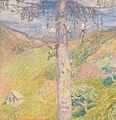With so many writers crowding the field these days, it’s always good to remember that it’s not enough to write beautiful phrases, sentences or even paragraphs. If no story or point is to be found, the most gorgeous writing on earth probably will have a few admirers but will probably not garner a huge audience.
Writing Tip for Today: So what’s the point (or story)?
- You must have something to say. You may have an unoriginal thing to say but you must have a unique or creative way of saying it. When a reader discovers she’s wasted valuable time for no discernible point or story, reader feels cheated.
- Your reader must have a clue of where your work is heading very early. Don’t allow your reader to wonder what your work is about. You’ll probably lose him if you don’t state your direction on the first couple of pages.
- You must not run too far afield of that story or point. Early in a writing career, it’s common to get off topic or write too many subplots that don’t support the main ideas. Learn to recognize a rabbit trail and be brave enough to cut it. You may keep all these gems in a folder marked “ideas,” or “snippets.”
- You must not hit readers over the head with your point. If you TELL your readers what the point is, you’ve taken away their job of figuring out that point and making their own conclusions about its meaning. Rather, SHOW them what you mean, with Concrete Sensory Detail (CSD), active verbs and restrained yet potent metaphor. Resist the Urge to Explain (RUE) is a good thing to keep in mind. Your readers will thank you for it.




